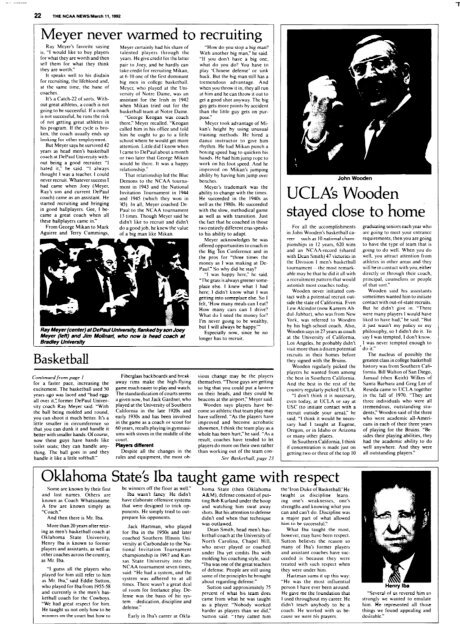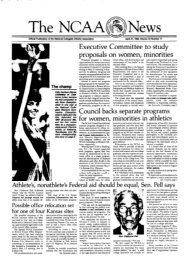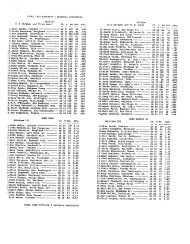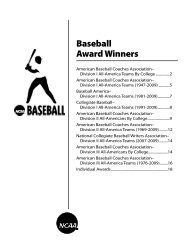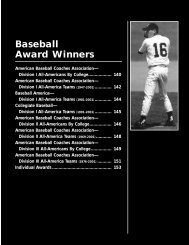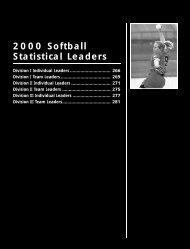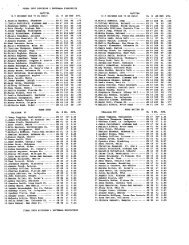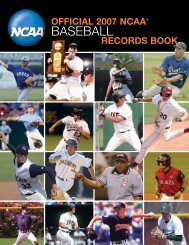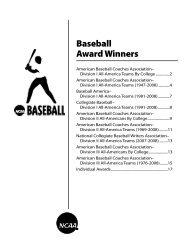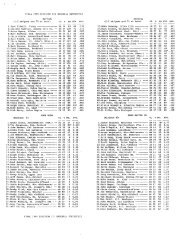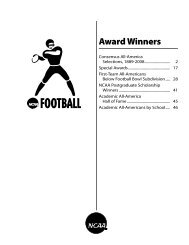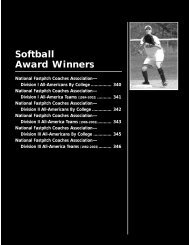The NCAA News
The NCAA News
The NCAA News
You also want an ePaper? Increase the reach of your titles
YUMPU automatically turns print PDFs into web optimized ePapers that Google loves.
-_ ----<br />
22 THE <strong>NCAA</strong> NEWS/March 11,1992<br />
Meyer never warmed to recruiting<br />
Ray Meyer’s favorite saying<br />
is, “I would like to buy players<br />
for what they are worth and then<br />
sell them fnr what they think<br />
they are worth.”<br />
It speaks well to his disdain<br />
for recruiting, the lifeblood and.<br />
at the same time, the bane of<br />
coaches.<br />
It’s a Catch-22 of sorts. With-<br />
out great athletes, a coach is not<br />
going to be successful. If a coach<br />
is not successful, he runs the risk<br />
of not getting great athletes in<br />
his program. If the cycle IS bro-<br />
ken, the coach usually ends up<br />
looking for other employment.<br />
But Meyer says he survived 42<br />
years as head men’s basketball<br />
coach at DePaul University with-<br />
out being a good recruiter. “I<br />
hated it,” he said. “I always<br />
thought I was a teacher. I could<br />
never recruit. Whatever success I<br />
had came when Joey (Meyer,<br />
Ray’s son and current DePaul<br />
coach) came as an assistant. He<br />
started recruiting and bringing<br />
in good ballplayers. Gee, I be-<br />
came a great coach when all<br />
these ballplayers came in.”<br />
From George Mikan to Mark<br />
Aguirre and Terry Cummings,<br />
Meyer certainly had his share of<br />
talented players through the<br />
years. He give credit for the latter<br />
pair to Joey, and he hardly can<br />
take credit for recruiting Mikan,<br />
at 6-10 one of the first dominant<br />
big men in collcgc basketball.<br />
Meyer, who played at the IJni-<br />
vcrsity of Notre Dame, was an<br />
assistant for the Irish in 1942<br />
when Mikan tried out for the<br />
basketball team at Notre Dame.<br />
“George Keogan was coach<br />
there,” Meyer recalled. “Keogan<br />
called him in his oflice and told<br />
him he ought to go to a little<br />
school where he would get more<br />
attention. Little did I know when<br />
I came to DePaul about a month<br />
or two later that George Mikan<br />
would bc thcrc. It was a happy<br />
relationship.”<br />
That relationship led the Blue<br />
Demons to the <strong>NCAA</strong> tourna-<br />
ment in 1943 and the National<br />
Invitation Tournament in 1944<br />
and 1945 (which they won in<br />
‘45). In all, Meyer coached De-<br />
Paul to the <strong>NCAA</strong> tournament<br />
I3 times. Though Meyer said he<br />
didn’t like to recruit and didn’t<br />
do a good job, he knew the value<br />
of a big man like Mikan.<br />
Ray Meyer (center) at DePaul Universiiy, flankedby son Joey<br />
Meyer (leff) and Jim Molinati, who now is head coach at<br />
Bradley University<br />
Basketball<br />
Continued from page 1<br />
for a faster pace, increasing the<br />
excitement. <strong>The</strong> basketball used 50<br />
years ago was laced and “had eggs<br />
all over it,‘: former DePaul Univer-<br />
sity coach Ray Meyer said. “With<br />
the ball being molded and round,<br />
you can shoot it much better. It’s a<br />
little smaller in circumference so<br />
that you can dunk it and handle it<br />
better with smaller hands. Of course,<br />
now these guys have hands like<br />
toilet seats; they can handle any-<br />
thing. <strong>The</strong> ball goes in and they<br />
handle it like a little softball.”<br />
Fiberglass backboards and break-<br />
away rims make the high-flying<br />
game much easier to play and watch.<br />
<strong>The</strong> standardization of courts seems<br />
a given now, but Jack Gardner, who<br />
played at the University of Southern<br />
California in the late 1920s and<br />
early 1930s and has been involved<br />
in the game as a coach or scout for<br />
60 years, recalls playing in gymnasi-<br />
ums with stoves in the middle of the<br />
court.<br />
Players different<br />
Despite all the changes in the<br />
rules and equipment, the most ob-<br />
“How do you stop a big man?<br />
With another big man,” he said.<br />
“If you don’t have a big one,<br />
what do you do? You have to<br />
play ‘Chinese defense’ or sink<br />
back. But the big man still has a<br />
tremendous advantage. And<br />
when you throw it in, they all run<br />
at him and he can throw it out to<br />
get a good shot anyway. <strong>The</strong> big<br />
guy gets more points by accident<br />
than the little guy gets on pur-<br />
pose.”<br />
Meyer took advantage of Mi-<br />
kani height by using unusual<br />
training methods. He hired a<br />
dance instructor to give him<br />
rhythm. He had Mikan punch a<br />
boxing speed bag to quicken his<br />
hands. He had him jump rope to<br />
work on his foot speed. And he<br />
improved on Mikan’s jumping<br />
ability by having him jump over<br />
benches.<br />
Meyer’s trademark was the<br />
ability to change with the times.<br />
He succeeded in the 1940s as<br />
well as the 1980s. He succeeded<br />
with the slow, methodical game<br />
as well as with transition. Just<br />
the fact that he coached in those<br />
two entirely different eras speaks<br />
to his ability to adapt.<br />
Meyer acknowledges he was<br />
offered opportunities to coach in<br />
the Big Ten Conference and in<br />
the pros for “three times the<br />
money as I was making at De-<br />
Paul.” So why did he stay?<br />
“I was happy hcrc,” hc said.<br />
“<strong>The</strong> grass is always greener some-<br />
place else. I knew what I had<br />
here; I didn’t know what I was<br />
getting into someplace else. So I<br />
felt, ‘How many meals can I eat?<br />
How many cars can I drive?<br />
What do I need the money for‘?<br />
I’m never going to be wealthy,<br />
but I will always be happy.“’<br />
Especially now, since he no<br />
longer has to recruit.<br />
vious change may be the players<br />
themselves. “Those guys are getting<br />
so big that you could put a lantern<br />
on their heads, and they could be<br />
beacons at the airport,” Meyer said.<br />
Wooden says players have be-<br />
come so athletic that team play may<br />
have suffered. “As the players have<br />
improved and become acrobatic<br />
showmen, I think the team play as a<br />
whole has been hurt,” he said. “As a<br />
result, coaches have tended to let<br />
players do more on their own rather<br />
than working out of the team con-<br />
SW Bask cl hall. pup 23<br />
Oklahoma State’s Iba taught game with respect<br />
Some are known by their first<br />
and last names. Others are<br />
known as Coach Whatsisname.<br />
A few are known simply as<br />
“Coach.”<br />
And then there is Mr. Iba.<br />
More than 20 years after retir-<br />
ing as men’s basketball coach at<br />
Oklahoma State University,<br />
Henry Iba is known to former<br />
players and assistants, as well as<br />
other coaches across thecountry,<br />
as Mr. Iba.<br />
“I guess all the players who<br />
played for him still refer to him<br />
as Mr. Iba,” said Eddie Sutton,<br />
who played for Ibafrom 1955-58<br />
and currently is the men’s bas-<br />
ketball coach for the Cowboys.<br />
“We had great respect for him.<br />
He taught us not only how to be<br />
winners on the court but how to<br />
be winners off the floor as well.”<br />
Iba wasn’t fancy. He didn’t<br />
have elaborate offensive systems<br />
that were designed to trick op-<br />
ponents. He simply tried to out-<br />
prepare his opponents.<br />
Jack Hartman, who played<br />
tor Iba in the 1950s and later<br />
coached Southern Illinois Uni-<br />
versity at Carbondale to the Na-<br />
tional Invitation Tournament<br />
championship in 1967 and Kan-<br />
sas State University into the<br />
<strong>NCAA</strong> tournament seven times,<br />
said: “He had a system, and the<br />
system was adhered to at all<br />
times. <strong>The</strong>re wasn’t a great deal<br />
of room for freelance play. De-<br />
fense was the basis of his sys-<br />
tem dedication, discipline and<br />
defense.”<br />
homa State (then Oklahoma<br />
A&M), defense consisted of put-<br />
ting Bob Kurland under the hoop<br />
and watching him swat away<br />
shots. But his attention to defense<br />
didn’t end when that techniuuc<br />
was outlawed.<br />
Dean Smith, head men’s basketball<br />
coach at the University of<br />
North Carolina, Chapel Hill,<br />
who never played or coached<br />
under Iba yet credits Iba with<br />
molding his coaching style, said:<br />
“Iba was one of the great teachers<br />
of defense. People are still using<br />
some of the principles he brought<br />
about regarding defense.”<br />
Sutton said approximately 75<br />
percent of what his team does<br />
came from what he was taught<br />
as a player. “Nobody worked<br />
harder as players than we did,”<br />
John Wooden<br />
UCLA’s Wooden<br />
stayed close to home<br />
For all the accomplishments graduating seniors each year who<br />
in .John Wooden’s basketball ca- are going to meet your entrance<br />
reer such as IO national cham- requirements, then you are going<br />
pionships in I2 years, 620 wins to have the type of team that is<br />
and an <strong>NCAA</strong>-record (shared going to do well. When you do<br />
with Dean Smith) 47 victories in well, you attract attention from<br />
the Division I men’s basketball athletes in other areas and they<br />
tournament -the most rcmark- will be in contact with you, either<br />
able may be that he did it all with directly or through their coach,<br />
a rccruitmcnt pattern that would principal, counselors or people<br />
astonish most coaches today. of that sort.”<br />
Wooden never initiated con- Wooden said his assistants<br />
tact with a potential recruit out- sometimes wanted him to initiate<br />
side the state 01 Calitornia. Fven contact with out-of-state recruits.<br />
I,ew Alcindor (now Kareem Ab But he didn’t give in. “<strong>The</strong>re<br />
dul-.Jahbar), who was from New were many players I would have<br />
York, was referred to Wooden liked to have had,” he said. “But<br />
by his high-school coach. Also, it just wasn’t my policy or my<br />
Wooden says in 27 years as coach philosophy, so I didn’t do it. IO<br />
at the University of California, say I was tempted, I don’t know.<br />
Los Angeles, he probably didn’t I was never tempted enough to<br />
visit more than a doren potential ’ do it.”<br />
recruits in their homes before <strong>The</strong> nucleus of possibly the<br />
they signed with the Bruins. greatest class in college basketball<br />
Wooden regularly picked the history was from Southern Caliplayers<br />
hc wanted from among fornia. Bill Walton of San Diego,<br />
the best in Southern California. .Jamaal (then Keith) Wilkes of<br />
And the best in the rest of the Santa Barbara and Greg Lee of<br />
country regularly picked IJCLA. Reseda came to IJCLA together<br />
“I don’t think it is ncccssary, in the fall of 1970. “<strong>The</strong>y are<br />
even today, at UCLA or say at three individuals who were all<br />
USC (to initiate contact with a tremendous, outstanding sturecruit<br />
outside your area),” he dents,” Wooden said of the three<br />
said. “I think it would be neces- who were academic all-Amerisary<br />
had I taught at Eugene, cans in each of their three years<br />
Oregon, or in Idaho or Arizona of playing for the Bruins. “Beor<br />
many other places. sides their playing abilities, they<br />
In Southern California, I think had the academic ability to do<br />
if concentration is made just on well anywhere. And they were<br />
getting two or three of the top 10 all outstanding players.”<br />
the‘lron Duke of Basketball.’ He<br />
taught us discipline learn-<br />
ing one’s weakncsscs, one’s<br />
strengths and knowing what you<br />
can and can’t do. Discipline was<br />
a maior Dart of what allowed<br />
him to be’successtul.”<br />
What Iba taught the most,<br />
however, may have been respect.<br />
Sutton believes the reason so<br />
many of Iba’s former players<br />
and assistant coaches have suc-<br />
ceeded is because they were<br />
treated with such respect when<br />
they were under him.<br />
Hartman sums it up this way:<br />
“He was the most influential<br />
person I have ever been around.<br />
He gave me the toundation that<br />
I used throughout my career. He<br />
didn’t teach anybody to be a<br />
coach. He worked with us be-<br />
Early in Iba’s career at Okla- Sutton said. “<strong>The</strong>y called him cause we were his players<br />
“Several of us revered him so<br />
strongly we wanted to emulate<br />
him. He represented all those<br />
things we found appealing and<br />
desirable.”


